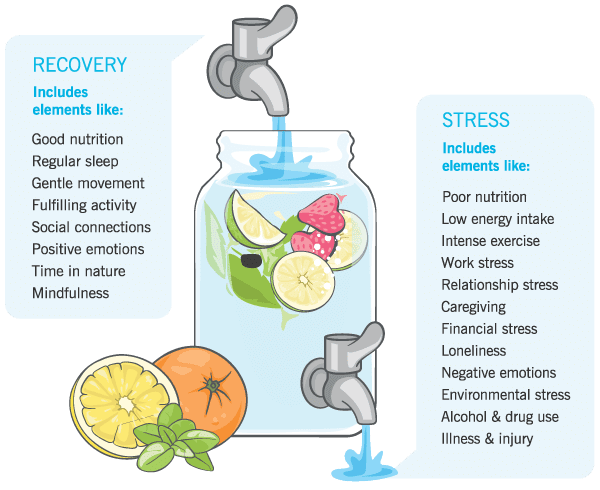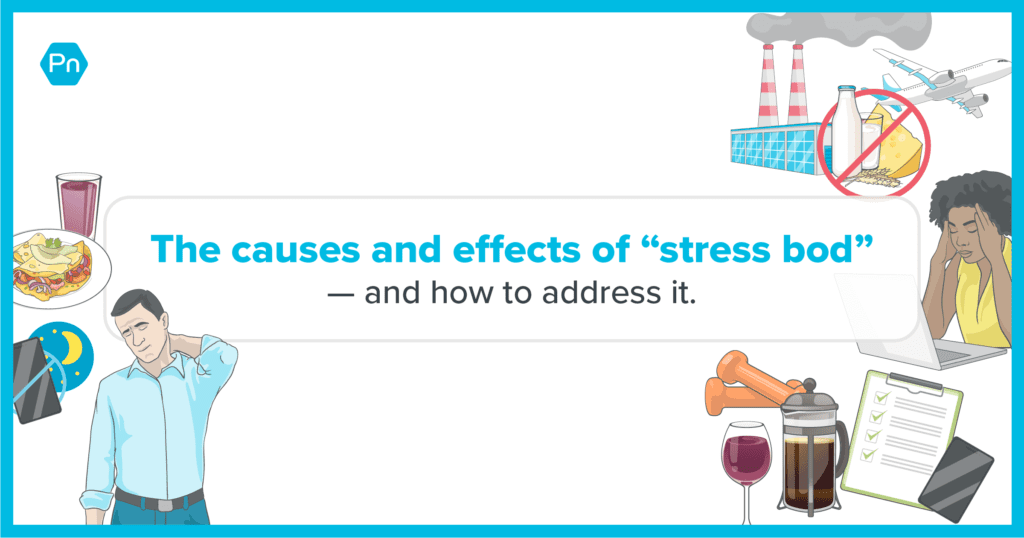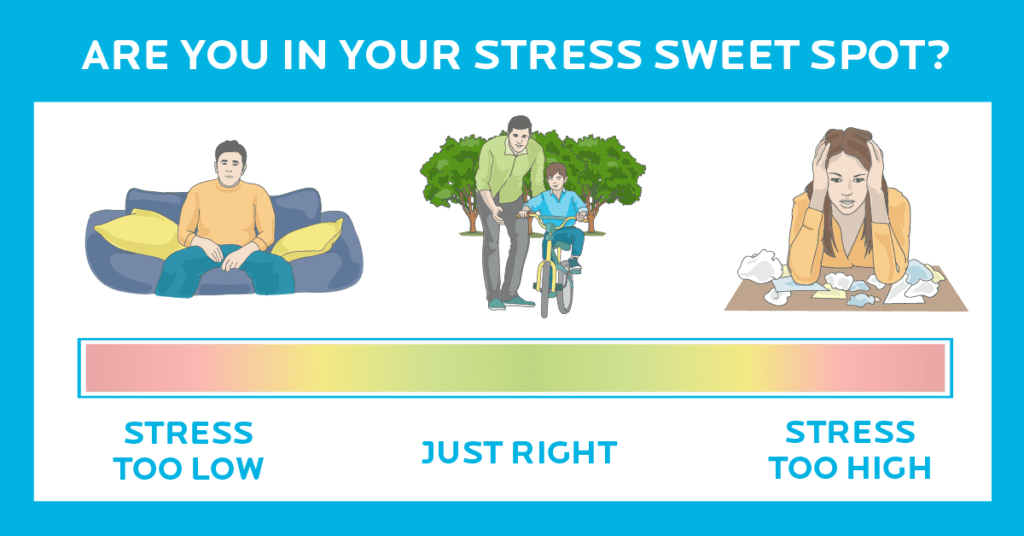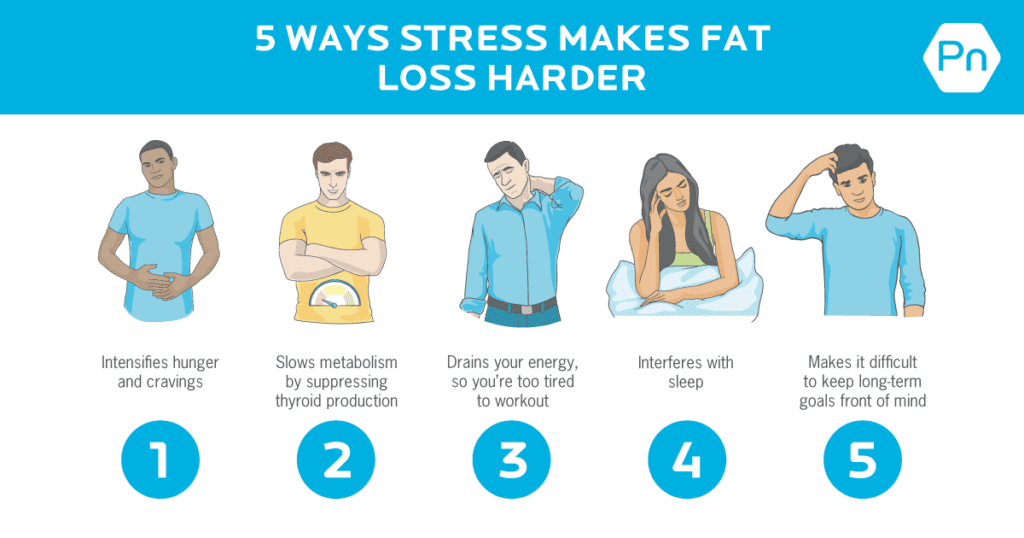Your roof isn’t leaking, your thyroid’s fine, and you’ve never been chased by a hungry tiger.
So why are you so exhausted, cranky, and foggy?!
We’d like to introduce you to invisible stress.
You’re probably familiar with visible stress. That’s the stuff that most of us register as obviously stressful—trying to console a screaming infant at 3:30 am, or doing a presentation in front of people who are paid to criticize your work.
Invisible stress, on the other hand, quietly does its dirty work beneath your level of awareness.
When enough of these silent stressors add up, however, you can feel as if you’ve just crawled out of the lion enclosure at the zoo.
Worse, you’re left wondering: “Why am I feeling so crummy? What’s wrong with me? Nothing dramatic happened!”
In this article, we’ll expose what causes five hidden stressors that can wear away at your health and wellbeing.
Even better, we’ll show you how to recover, so you can return to your life with more energy, wisdom, and resilience.
++++
Stressor #1: Information overload & filter failure
Technology has given us many great things—including an end to couples fighting about the need to ask for directions.
One double-edged technological gift: An overabundance of information.
Many of us have jobs that require us to process reams of electronic fodder—in the form of emails, video calls, and chat messages.
On top of that, we often fill our non-work hours with more electronic material: social media, YouTube reaction videos, and clicking on that ad for shoes and falling into a black hole of online shopping.
People used to call this nerve-jangling problem information overload. But, as computer scientist and productivity sage Cal Newport has popularized: The information itself isn’t the problem.
The real problem is this: We fail to filter out the junk.
Without the skill of consciously choosing where to place our attention (filtering and focusing), our attention gets yanked away from us like leaves in the wind.
Imagine a busy emergency room where nobody triaged and prioritized. Stuffy noses and sprained ankles would be as important—and randomly attended to—as someone who’d just been in a catastrophic car accident.
Fortunately, emergency personnel learn to identify what matters most right now and quickly switch gears to crucial priorities as needed.
You can learn to do the same.
Signs you’re suffering from this stressor
Consider if any of the following are true for you:
✓ You feel tired and edgy after spending time on the internet or watching the news.
✓ You don’t spend as much time on your health, fitness, and life goals, because you get distracted by what’s going on online or with the latest Netflix release.
✓ You keep finding yourself somewhere in an information ocean, not sure how you got there.
✓ The idea of a digital vacation feels scary—but maybe also a teeny bit freeing.
✓ You struggle to know where to put your attention, because everything’s trying to grab it.
✓ It all just feels like… too much.
How to recover
A focus filter allows you to consciously choose—with purpose—where you want to place your attention.
To create one, you’ll first want to spend time thinking about who you are (a.k.a. your identity) as well as what matters to you (a.k.a. your values).
Maybe you’re a family person who values time with your kids.
Or you’re a fitness enthusiast who cares deeply about breaking a sweat in the great outdoors.
There are no right or wrong answers here. This isn’t about what your parents want for you or what you think society wants for you.
Rather, it’s about what YOU want for YOU.
For help, check out our Identity, Values, and Goals chart.
And, yes, this is hard work. If you feel lost trying to identify your values, here’s a cool way to figure it out. Ask yourself:
What makes you angry?
Anger can be a sign your values have been violated. The following table lists a few examples.
| I got mad when… | So _________ is important to me |
|---|---|
| Someone lied to me | Honesty |
| I got ripped off | Fairness |
| My boss asked me to work late and miss my son’s game | Family |
| Someone was rude to me | Courtesy |
Once you know your identity and values, take an honest look at where you spend your time and energy.
Are you putting enough time and energy toward what you value?
Heads up: Your time, energy, and attention will always be limited.
When you say “yes” to what you value, you’ll probably have to say “no” to something else.
Stressor #2: Toxic positivity
Remember those self-improvement gurus from the 90s and aughts who advised us to “think positive” in the face of stress?
Whether you’d just stubbed your toe or lost your entire family in an avalanche, the advice was the same: “You can find a silver lining! Just stay positive! Everything happens for a reason!”
However, we now know contrived positivity can be counterproductive—even harmful: When it’s not authentic, positivity can actually intensify the stress we experience.1,2
Also, slapping an “EVERYTHING’S FINE” label over everything can block us from recognizing problems, which stops us from solving them.
Signs you’re suffering from this stressor
Positive thinking isn’t all bad.
Take the belief you can deal with and learn from the many complications life throws your way. That can help you feel capable, resourceful, and strong, and lead to growth.
Toxic positivity, however, generally leads to stagnation.
You’re not moving through challenges with courage and vulnerability. Rather, you’re getting stuck in “Everything’s okay! I don’t have to deal with that because it’s not a problem! I swear!”
More signs that toxic positivity is keeping you stunted:
✓ You don’t permit yourself to experience or discuss difficult emotions such as anger or grief.
✓ Repressed negative emotions seem to leak out in other ways: muscle tension, disappearing wine bottles, disproportionate explosions of rage when you can’t find your keys.
✓ You feel guilty or ashamed whenever you experience a negative emotion like frustration or sadness. (“I have no right to feel this. My life is okay and so many other people are suffering.”)
✓ You feel uncomfortable when people around you are suffering, so you say things like “just look on the bright side.”
✓ You’ve unsuccessfully started a million gratitude journals and hated them immediately.
How to recover
Pay attention to your full range of emotions—especially the uncomfortable ones you wish you didn’t have to experience.
When you notice a negative emotion, name it. This can be as simple as saying (out loud or inwardly): “I’m feeling angry” or “I’m so lonely right now.”
Notice how that feeling lives in your body. Are you feeling restless? Is your jaw tight? Face hot? Tears poking at your eyes?
Be curious. Is there something important or valuable that the emotion is trying to tell you? If the emotion had a voice, what would it say? Be honest with yourself, at least in your own head.
See if you can welcome—or at least feel a little softer towards—the feeling as a necessary and normal life experience that’s neither good, nor bad.
Stressor #3: Your neighbor’s leaf blower
Lawn equipment, car alarms, barking dogs, and other noisy goings on are more than just annoying.
They can trigger a body-wide stress response.
In order to survive, we evolved to perceive, interpret, and respond to the world’s cacophony of sensory information.
Based on the sounds around us, your body will perk up (say, to the sound of a crying baby), jolt you into action (to respond to a blaring car horn), or just do nothing (interpreting the constant hum of the air conditioner as NBD).
We’re well equipped to process much of this sensory stimuli.
However, when this information overwhelms our ability to process it, it becomes a stressor.
This is especially true when that noise is yammering on when you’re trying to finish that assignment your boss slammed in your inbox this morning.
Or listen to that lecture you know will be covered on the exam.
Or, heck, just relax and have some peace and quiet.
Signs you’re suffering from this stressor
Some noises are almost universally stressful. Think: the off-key teenage punk rock band that practices in a neighbor’s garage.
If the noise goes on long or often enough, you’ll notice symptoms of stress.
Some of us are unusually sensitive to sensory input.
We feel uneasy in situations that don’t bother other people—such as a crowded restaurant with lots of competing conversations. If others around us don’t understand or feel the same way, the stress gets amplified.
You might be unusually sensitive to sensory input if you…
✓ Feel overstimulated and/or uncomfortable in environments other people find relaxing or neutral (restaurants, doctor’s waiting rooms)
✓ Avoid certain environments (like airports and malls) because you worry you won’t be able to handle all the commotion
✓ Have other sensory sensitivities. For example, you reject many foods because of taste or texture, or diligently rip tags off clothes because the little pieces of fabric torment you
How to recover
We wish we could tell you about a magic switch that would turn off the world.
Truth is, some background noises are inevitable and out of our control.
But not all of them. To regain a sense of control, consider two questions:
Question #1: How might you turn down the volume on sounds that trigger your stress?
Could you close the blinds during work calls to prevent your dog from barking at the mail carrier?
Wear noise-cancelling headphones in crowded environments to muffle background noise?
Talk to your neighbors about mutually-agreed upon quiet hours?
Question #2: How might you invite more quiet?
Are there ways to build “quiet breaks” into your day?
Some of our clients like to stop at a park for 10 minutes before heading home after a stressful day.
Others hang out in “sensory rooms” (restorative spaces designed specifically for people with sensory issues) in airports, malls, and other places where these rooms are available.
Some families schedule “quiet time” during which everyone can be immersed in their own silent pursuits: coloring, reading, listening to music with headphones, or building Legos.
(Shhhh. That’s the sound of a pin drop.)
Stressor #4: Emotional labor
Imagine you work in customer service.
All day long, you must pretend to care deeply about the often minor concerns of your customers.
Even when people are rude or offensive, you must adopt a pleasant tone and stick to the script, which in part, involves you repeatedly saying “I’m sorry” for a situation that isn’t remotely your fault.
Nurses, therapists, coaches, and even parents might relate: No matter what kind of day you’re having, you still try to seem caring and cheerful.
That’s emotional labor, a term coined by sociologist Arlie Hochschild in the 1980s. It’s the internal work needed to actively manage the feelings of others, as well as control our own response.
And it can be as exhausting as laying bricks on a summer day in Miami.
If we don’t account for this emotional labor, and recover from it appropriately, we risk burnout.
Signs you’re suffering from this stressor
Consider whether any of the following are true for you:
✓ As a marginalized person at work, you feel you must plaster a smile to your face in order to not provoke coworkers who make hurtful, demeaning comments.
✓ You work in a profession that involves concealing your own emotions and prioritizing the emotions of the customer or client. Think: healthcare, law, customer service, social work, and you guessed it… coaching.
✓ You feel exhausted at the end of the day because you spend most of it graciously placating cranky people. (Hi, caregivers of small children and teenagers.)
✓ You’re the one in your household who’s always smoothing ruffled feathers, playing peacekeeper, and trying to ensure everyone gets along—ignoring your own desire to tell your housemate to take a hike, your parent to quit telling you how to live your life, or your spouse to clean up their own #^@%! mess.
How to recover
Consider this question:
Where can you find emotional rest?
Boundaries are a key tactic, especially if you’re a high-empathy person who often takes on others’ problems and emotions.
Deciding when—and when not—to get emotionally invested is a skill that most coaches (and caring people with feelings) have to work to develop.
Maybe you…
▶ Create boundaries between home and work, perhaps by not checking work email during dinner, or after a set hour.
▶ Have a crucial conversation with your family during which you explain that you’re no longer the United Nations for their infighting.
▶ Schedule 5-minute breaks into your workday so you can slam a medicine ball into a wall, take a walk around the block, or stare out a window.
▶ Get extra support—for instance, from an ally or therapist who understands your struggles.
The best form of emotional recovery will vary from one person to another.
Experiment with options until you find what works best.
Stressor #5: Microaggressions
Microaggressions are small, often subtle, everyday statements or actions that communicate hostile, derogatory, and negative attitudes towards someone.
They can sound like…
| To an Asian American: | “Where are you from? I mean where are you really from?” |
| To a person of color: | Clutches their purse more tightly. |
| To a same-sex couple with a child: | “So who’s the real parent?” |
| To a person in a larger body: | “You’d look so good if you just lost weight.” |
| To a person who is gender-diverse: | “Aren’t you in the wrong bathroom?” |
| To a person with a visible disability: | Gets ignored. |
To those who haven’t experienced them, microaggressions might seem too small to matter.
These are silly little everyday things, why complain?
Yet microaggressions often sting. A lot. Like, “Dang, was that a paper cut or a hot chainsaw??”
Though subtle and, at times, unintended, these jabs have a significant impact.
They can build over time, wearing you down and affecting how you experience the world.
And telling yourself to “suck it up” or “I shouldn’t be bothered by this” can backfire, making the stress even worse.
Signs you’re suffering from this stressor
After years of aggregated pokes and pushes, you may:
✓ Continually brace for impact, waiting for the next shot to come
✓ Feel exhausted. Change may feel like another chore to face
✓ Become suspicious of the people around you, even if they seem to have good intentions
✓ Mistrust an entire group of people or avoid particular situations
How to recover
There’s one bright spot: Micropower.
It involves taking small actions on your own behalf to resist the feeling of being beaten down by your circumstances.
Here are some examples of how someone might discover their micropower.
▶ Find communities, spaces, and allies who understand specific struggles—such as coworkers who “get it,” a support group, or a therapist who understands this particular type of marginalization.
▶ Ask, “What do you mean by that?” and put the aggressor on the spot.
▶ Discern and prioritize: Is this the battle you want to fight right now?
▶ Practice aggressive self-care. Double down on recovery and replenishing. Microaggressions can be draining.
▶ If it’s safe, call it out. Say, “That term isn’t used any more. Please don’t refer to me like that.”
Or, “I’m sure you didn’t mean to imply ____, but it came across as ____. Instead could you please _____.”
(This is scary and has potential risks, so build a base of support and allies first, if you can.)
▶ If you have the resources, build something out of your experience that benefits others.
For instance, after years of experiencing stigma and discrimination, Coach Meghan Crutchley started Habit Queer, a coaching and speaking business that uses the PN behavior-based approach to support LGBTQ+ clients.
Even if the rest of the situation sucks right now, these actions help you gain crucial control and empowerment.
Micropower for coaches
If you’re serving clients from groups that have been traditionally marginalized or discriminated against (such as people from racialized groups, recent immigrants, LGBTQ+ people, people who think or learn differently, people with disabilities, and so on), assume they’ve dealt with microaggressions.
As a coach, you’ll want to integrate this understanding into your own practice.
Consider how to provide safe, secure social support:
- Offer compassion. Try to empathize and understand your clients’ hesitation, discomfort and anxiety. Recognize they may have dealt with innumerable social hurts that affect their perceptions, engagement, and comfort within certain spaces.
- Choose your words thoughtfully and sensitively. Small things (like well-intentioned constructive criticism) can feel like an attack when a client’s threat radar is up.
- Make the client the boss. Microaggressions can feel like they take away our power to act and advocate. Help clients feel more in control and safe by emphasizing their ownership over their own change process. Help them find opportunities for acts of productive micropower.
Less stress, more recovery
When you see hidden stressors clearly, you have a better chance of being able to take empowered steps to recover from them.
Think about the balance of stress and recovery as a tank that can be simultaneously filled (through recovery) and drained (from stress).

Using the strategies listed in this story as well as what’s shown in the above illustration, aim to:
- Put more in the tank by cranking up recovery practices
- Slow or plug the leak by decreasing or better managing stress
You won’t be able to eliminate stressors—invisible or otherwise—completely. But by slowing the leak as well as filling the tank, you can feel a little more equipped for life.
References
Click here to view the information sources referenced in this article.
If you’re a health and fitness pro…
When your clients are stressed and exhausted, everything else becomes a struggle: going to the gym, choosing healthy foods, and managing cravings.
But with the right tools, you can help your clients overcome obstacles like chronic stress and poor sleep—leading them toward the lasting health transformations they’ve always wanted.
PN’s Level 1 Sleep, Stress Management, and Recovery (SSR) Coaching Certification will give you these tools. And it’ll give you confidence and credibility as a specialized coach who can solve the biggest problems blocking any clients’ progress. (You can join the SSR Early Access List for our biggest discount + exclusive perks.)








Share